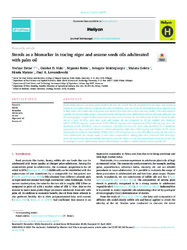| dc.contributor.author | Deme, Tesfaye | |
| dc.contributor.author | Haki, Gulelat D. | |
| dc.contributor.author | Retta, Nigussie | |
| dc.contributor.author | Woldegiorgis, Ashagrie | |
| dc.contributor.author | Geleta, Mulatu | |
| dc.contributor.author | Hinsta, Mateos | |
| dc.contributor.author | Lewandowski, Paul A. | |
| dc.date.accessioned | 2023-05-24T09:41:10Z | |
| dc.date.available | 2023-05-24T09:41:10Z | |
| dc.date.issued | 2021-04 | |
| dc.identifier.citation | Deme, T., Haki, G. D., Retta, N., Woldegiorgis, A., Geleta, M., Mateos, H., & Lewandowski, P. A. (2021). Sterols as a biomarker in tracing niger and sesame seeds oils adulterated with palm oil. Heliyon, 7(4), e06797. | en_US |
| dc.identifier.issn | 24058440 | |
| dc.identifier.uri | 10.1016/j.heliyon.2021.e06797 | |
| dc.identifier.uri | https://hdl.handle.net/13049/696 | |
| dc.description.abstract | Food adulteration is a serious social problem all over the world. The oil obtained from the niger and sesame is known for its quality and has a high market value in Ethiopia. The cost of the oil obtained from these oilseed crops is high unlike other plant oils, thus prone to be mixed with other cheap oils to increase profits. The study aimed to quantify the sterol profile of niger seed and sesame oils thereby trace adulteration of these oils with palm oil. Gas Chromatography coupled to Mass Spectrometry was used to analyze the sterol fractions of oils. A blend of palm oil, at a level of 10%, with niger seed and sesame oil was prepared. In all the studied oils; sitosterol (467.2–2778.96 mg/kg), campesterol (295.9–869.85 mg/kg) and stigmasterol (125.6–920 mg/kg) were the dominant sterols identified. Lupeol, Lanosterol, and Olean-12-en-3-one were only identified in a significant proportion for niger seed oil. Moreover, cholestroltrimethyl silyl ether (19.9 mg/kg) and 24-Nor-22,23- methylenecholest-5-en-3β-ol trimethylsilyl (TMS) ethers (139.14 mg/kg) were only identified in palm oil and used to trace adulteration. An attempt made to trace these compounds by mixing palm oil at a level of 10% with niger seed and sesame oils was successfully detected its presence. Hence, as the physicochemical properties of oils can be arranged to cover adulteration, marker identification provides a reliable identity of the specific oil. | en_US |
| dc.language.iso | en | en_US |
| dc.publisher | Elsevier Ltd | en_US |
| dc.relation.ispartofseries | Heliyon;7(4), e06797 | |
| dc.subject | Adulteration | en_US |
| dc.subject | Biomarker | en_US |
| dc.subject | GC-MS | en_US |
| dc.subject | Niger seed oil | en_US |
| dc.subject | Sesame oil | en_US |
| dc.subject | Sterols | en_US |
| dc.title | Sterols as a biomarker in tracing niger and sesame seeds oils adulterated with palm oil. | en_US |
| dc.type | Article | en_US |

